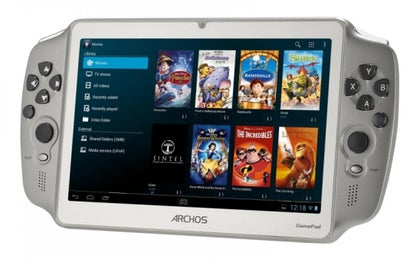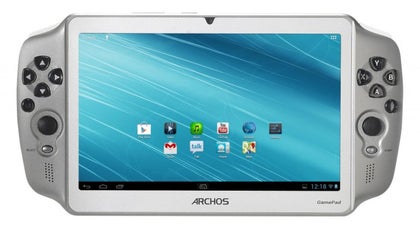Archos Gamepad review
A great idea, but the Gamepad only plays nice with certain games
Mobile gaming has come a long way since the humble Nintendo Gameboy. Almost everyone has a mobile device that keeps them entertained while travelling, but many games simply aren’t suited to touchscreen controls. Thankfully, the 7in Archos Gamepad has dedicated gaming buttons which should solve the problem and make more complex games much easier to play.

With a D-pad, twin analogue sticks, six face buttons, left and right shoulder buttons and start and select buttons, the Gamepad has almost the same number of inputs as an Xbox or PlayStation 3 controller. Indeed, it looks a little like an oversized Sony PlayStation Vita.
The buttons make the tablet larger than you’d expect, and much wider than a Nexus 7; we couldn’t fit it in a pocket without it poking out of the top. The power and volume controls are located on the top edge of the Gamepad, along with a MicroUSB port, a 3.5mm audio output and a mini HDMI output. It also has a MicroSD card slot should you need more storage space, as the 8GB of built-in storage will only get you so far, especially once you start adding more detailed games, which can be gigabytes in size.

The 7in display dominates the front of the tablet, but its 1,024×600 maximum resolution is no match for the 720p Nexus 7, and appalling viewing angles often make it difficult to see what’s on screen. The screen’s glossy finish doesn’t help either, as light reflections are a real issue. Brightness is low, even when turned up to the highest setting, and both colour and contrast are lacking, producing washed-out images that failed to impress when playing games or watching video.

The Gamepad has a front-facing camera for video calls, but no rear camera for taking pictures. Its picture quality is terrible, and even brightly lit subjects lack detail, but it will suffice for the usual Skype conversations.
The Gamepad is powered by a dual-core processor with a clock speed of 1.6GHz. It’s paired with 1GB of RAM and a quad-core Mali 400 graphics processor. The Samsung S3 also uses the Mali 400 GPU, so it should theoretically be good at running games.
Unfortunately, it’s not particularly adept at running Android 4.1 Jelly Bean, and it regularly hangs while you wait for apps to load and menus to open. It scored 4502 in the Quadrant multimedia benchmark and completed SunSpider in 1402ms. These are both respectable results, so it’s difficult to see why the operating system feels so sluggish.
We’re not impressed by the performance of its battery either, as the Gamepad managed just under five hours in our video playback test. This isn’t a good result, and you can expect that figure to be reduced further when playing games, especially more computationally demanding 3D titles.
Basic Specifications | |
|---|---|
| Rating | *** |
| Processor | ARM Cortex A9 |
| Processor clock speed | 1.6GHz |
| Memory | 1.00GB |
| Memory slots | 1 |
| Memory slots free | 0 |
| Maximum memory | 1GB |
| Size | 119x230x15mm |
| Weight | 330g |
| Pointing device | touchscreen |
Display | |
| Viewable size | 7 in |
| Native resolution | 1024×600 |
| Graphics Processor | Mali 400 |
| Graphics/video ports | micro HDMI |
| Graphics Memory | 1,024MB |
Storage | |
| Total storage capacity | 8GB |
| Optical drive type | none |
Ports and Expansion | |
| Bluetooth | no |
| Wired network ports | none |
| Wireless networking support | 802.11n |
| PC Card slots | none |
| Supported memory cards | MicroSDHC |
| Other ports | headphone out |
Miscellaneous | |
| Carrying case | No |
| Operating system | Android 4.1 |
| Operating system restore option | none |
| Software included | none |
| Optional extras | none |
Buying Information | |
| Warranty | one year RTB |
| Price | £120 |
| Details | www.archos.com |
| Supplier | http://www.currys.co.uk |










